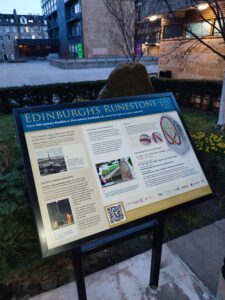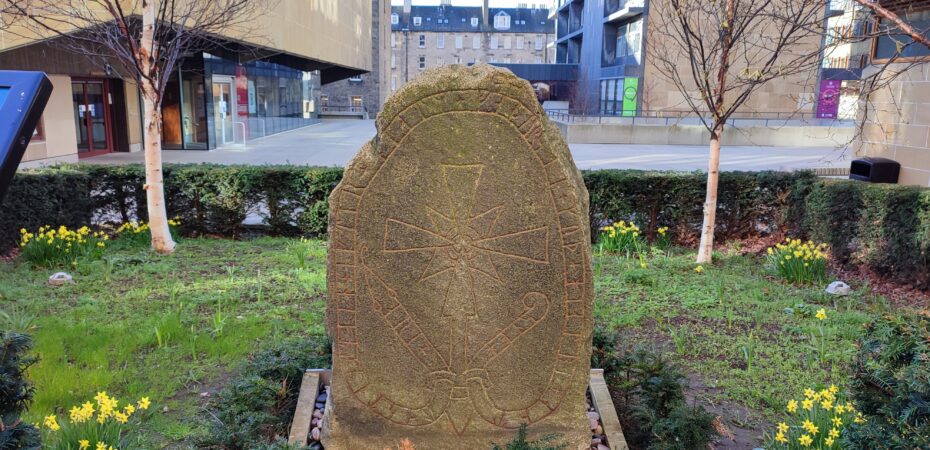Simon Gilmour (PhD Archaeology 2000) outlines the humanity behind archaeology and heritage through the fascinating history of the 11th century Edinburgh Runestone, and his work to rehome it at the University of Edinburgh.
Current treasured object: The book I’m reading at the moment. Any book at all, it represents my own time!
Song of the moment: Google Play chose to put on Seven Nation Army by The White Stripes after I’d walked the dog, which isn’t a bad choice.
The first thing you noticed when you woke up this morning: That my son wasn’t awake. He’s usually an early riser at 5.30am, but peace and quiet this morning!
———————————————————
I got into archaeology completely by accident.
Well, that’s not entirely true. I grew up in Aberdeenshire, where we have lots of stone circles; I remember my Gran was absolutely besotted with them. Every time she came up, she’d take us to go and visit the things. So, I kind of grew up with them in the background, but it never at any point made me think, “oh, I must become an archaeologist!”
Years later, I went to a University open day at Edinburgh with a friend. It was my friend who was actually going – I wasn’t even thinking about it at that time. There were desks for each subject, arranged alphabetically around the hall. The first one was Arabic, which I thought would be really cool to study. So I went up to the the table: nobody there. Alphabetically, the next one was Archaeology, so I ended up speaking to them instead. But I thought, “this is cool!”
The problem is once you call something ‘archaeological’, you switch people off. Archaeology is just a process to understand our past; it’s actually about people.
The first archaeological excavation that I went on was to a hillfort site in rural France, as a first year at Edinburgh. The local farmers had heard President Mitterand was supposed to be officially visiting and, in protest, started chopping down trees, blockading roads up to the fort. So the French sent in the gendarme – riot police – in huge armoured buses.
My memory’s slightly blurry, but we somehow ended up among the farmers, en route to a clash with the riot police. We got out of there just in time and watched from afar, eating the massive feast meant for Mitterand. Sitting there, watching helicopters circling, we were like, “this is archaeology? This is what we’re doing? This is awesome!”
I went on to work in and outside of heritage for a few years, eventually becoming Director of The Society of Antiquaries of Scotland. The Society has been around for 240 odd years, ever since it got a royal charter in 1783. Today, we advocate and speak up for heritage, as well as offering people across the world access to factual, good quality information about Scotland’s past.
 From the outset, members of the society would bring objects from around the world to showcase. One of these is the Edinburgh Runestone, a genuine 11th century Swedish runestone carved by a Runemaster named Erik. We don’t know much about him, but from what’s carved on the stone there are two things we know he was trying to convey.
From the outset, members of the society would bring objects from around the world to showcase. One of these is the Edinburgh Runestone, a genuine 11th century Swedish runestone carved by a Runemaster named Erik. We don’t know much about him, but from what’s carved on the stone there are two things we know he was trying to convey.
One, the stone was “raised in memory of Hjalmr, his father”. We don’t know who his dad was, or what he did, but Erik was obviously really proud of him. Two, he wanted to show off his piety, his Christianity, which was less widespread in 11th century Sweden. Fundamentally, it’s saying, “we’re here. We exist. My father lived here before me. And look, aren’t we good people?”
I think to some extent, these stories bring people closer together. It makes us recognise we’re all humans. We all have things we want to do in life; that‘s the same now as it is in the past.
So how did it end up in Edinburgh? As far as we can tell from the records, a man in 18th century Sweden dug it out of the ground on his adopted father’s estate. He stuck this three tonne block of granite on a cart, then on a boat, right across the sea to Leith and straight to the Society’s doorstep. I still don’t quite understand why!
It was then eventually gifted to the proprietors of Princes Street and placed just below the battlements of Edinburgh Castle. But over time, the knowledge and understanding of it just disappeared. It couldn’t possibly be real, people said, because why would a real Swedish runestone be sitting in the centre of Edinburgh? Then one day, a couple from Sweden came to visit me and said, “did you know you have this runestone? It comes from my father’s farm.”
We quickly realised the stone was at risk of damage at its old site, so agreed it needed to be moved and began searching for its new home. One of our fellows, Alan Macniven, suggested a location at the University’s School of Literatures, Languages and Cultures in George Square, fittingly right near their home of Scandinavian Studies.
People can see it now, just as it was intended to be seen back in the 11th century.
Most importantly, people can see it now, just as it was intended to be seen way back in the 11th century. Students of Scandinavian Studies get a piece of Swedish history right on their doorstep, and anyone local can discover the stone and its history in the George Square thoroughfare.
The whole ethos of the Society of Antiquaries is to get knowledge out there, making it free, available and accessible to all. This is the story of one object, one thing that we knew about our past. But there are literally an infinite number of objects, places and things which will drive people to the same questions all over Scotland.
Return to Issue 04 of Enlightened
——————————————————–
Related links:
Storyteller Svend-Erik Enghe brings to life the story of the runestone, from its creation in 11th-century Scandinavia to its new home outside the University of Edinburgh. You can watch the video he presents for the Society of Antiquaries of Scotland below.
The Society of Antiquaries of Scotland
Simon’s 2019 upate on the Edinburgh Runestone’s conservation



